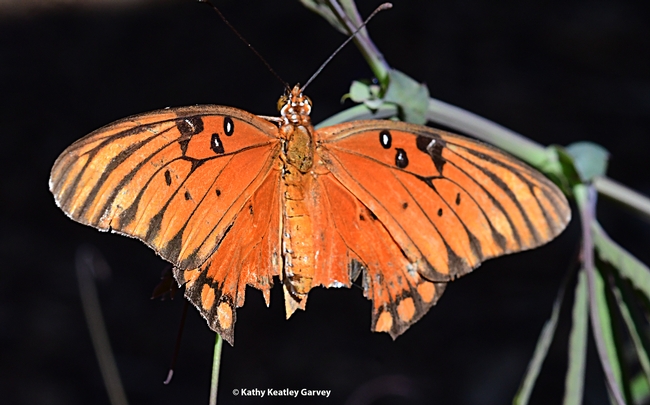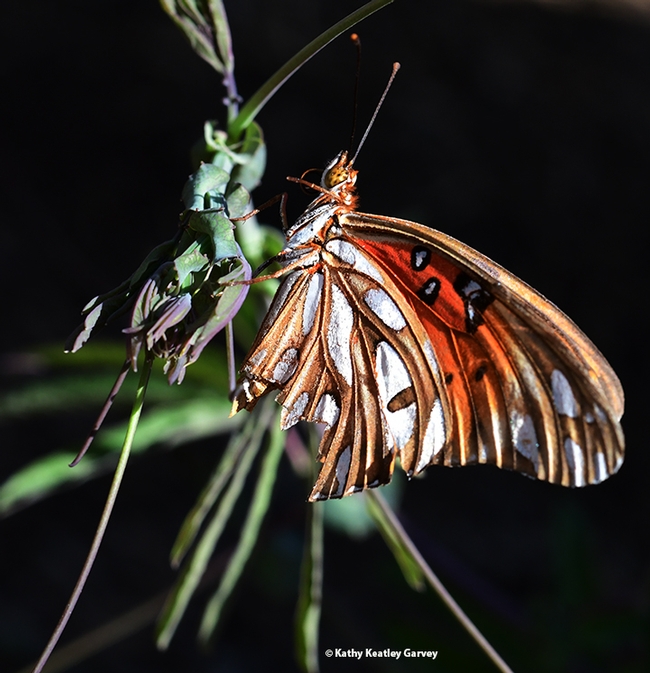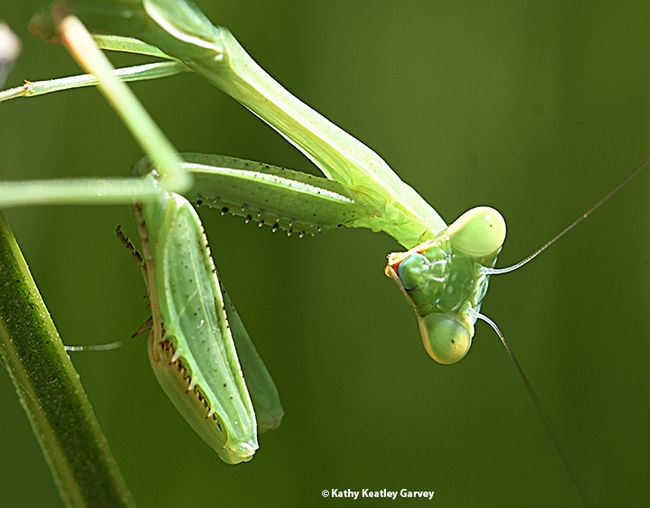- Author: Kathy Keatley Garvey
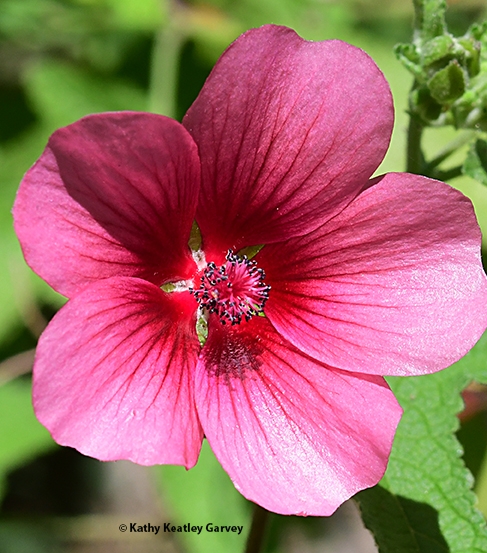
What's a honey bee to do when one of her favorite flowers, cape mallow (Anisodontea sp. "Strybing Beauty") is not open for bees-ness.
Well, leave it to the bee to find a way.
We recently witnessed a honey bee encountering a yet-to-open flower in the early morning. No entry! No way? And right at the beginning of National Honey Month, too. (USDA's National Honey Board founded the event in 1989 to celebrate the beekeeping industry and honey.)
As for Anisodontea, it's a perennial shrub that likes full sun.
It likes bees that pollinate it, too. It just closes at night and reopens in the morning.
Interested in keeping bees or knowing more about bees? The California Master Beekeeper Program (CAMBP) lists a number of bee classes on its website. The program, launched and directed by Cooperative Extension apiculturist Elina Lastro Niño, based in the UC Davis Department of Entomology and Nematology, educates and trains bee ambassadors. You can become a Master Beekeeper and "communicate the importance of honey bees and other pollinators" within your community and serve as mentor for other beekeepers. Master Beekeepers are the "informational conduit between the beekeeping communities throughout the state and the UC Cooperative Extension staff," according to Niño and program manager Wendy Mather on their website. (Email camasterbee@gmail.com for more information.)
Currently available are three online courses or webinars:
Seasonal Honey Bee Colony Management in Southern California, Online
- Saturday, Sept. 25, 2021, 9 a.m. to noon, South Coast Research and Extension Center, Irvine
- Event details
- Register here: https://registration.ucdavis.edu/Item/Details/730
Broodminder: Apiary Technology and Honey Bee Health, Online
- Saturday, Oct 9, 2021, 10 a.m. to noon
- Event details
- Register here: https://registration.ucdavis.edu/Item/Details/739
Exploring Beekeeping 001 #2 Online
- Saturday, Oct 16, 2021, 9 a.m. to noon, South Coast Research and Extension Center, Irvine
- Event details
- Register here: https://registration.ucdavis.edu/Item/Details/733
Unlike flowers that close, the California Master Beekeeping Program does not, despite the COVID-19 pandemic that continues to grip us. CAMBP has just found another way--online.
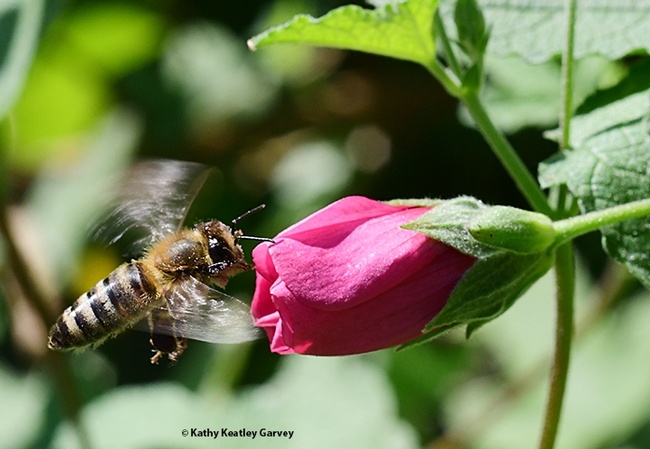
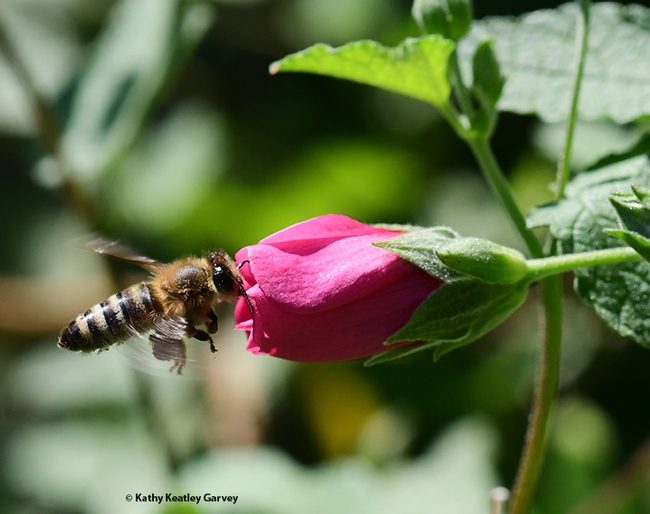
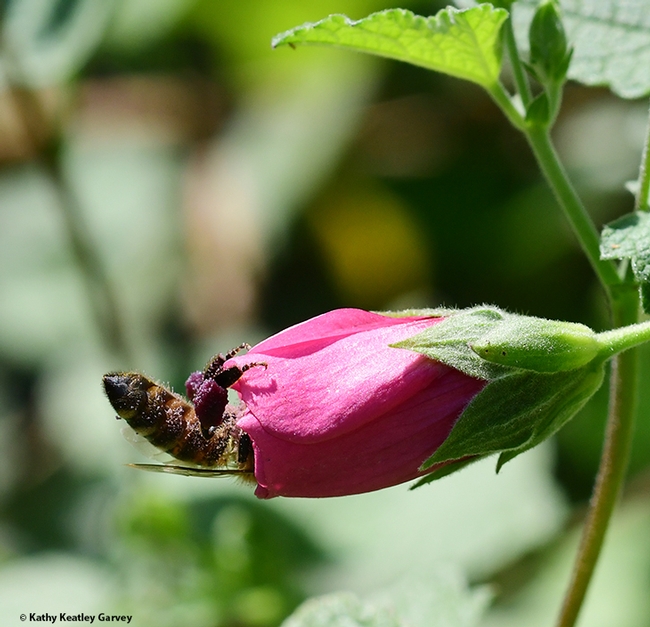
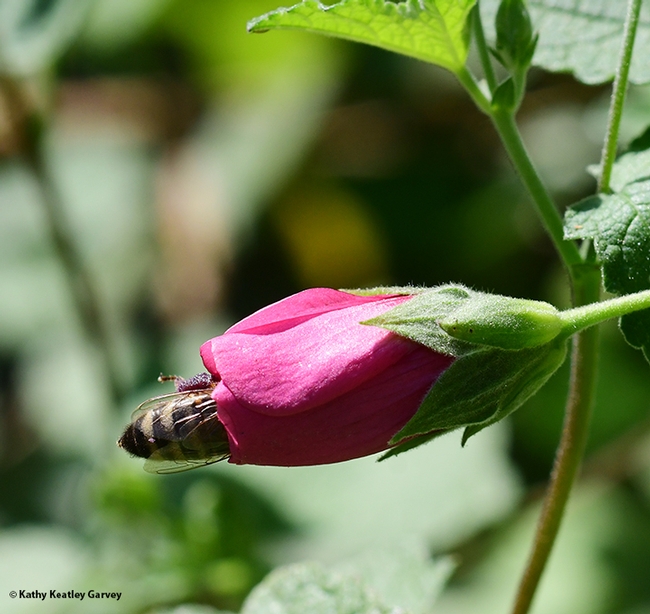
- Author: Kathy Keatley Garvey
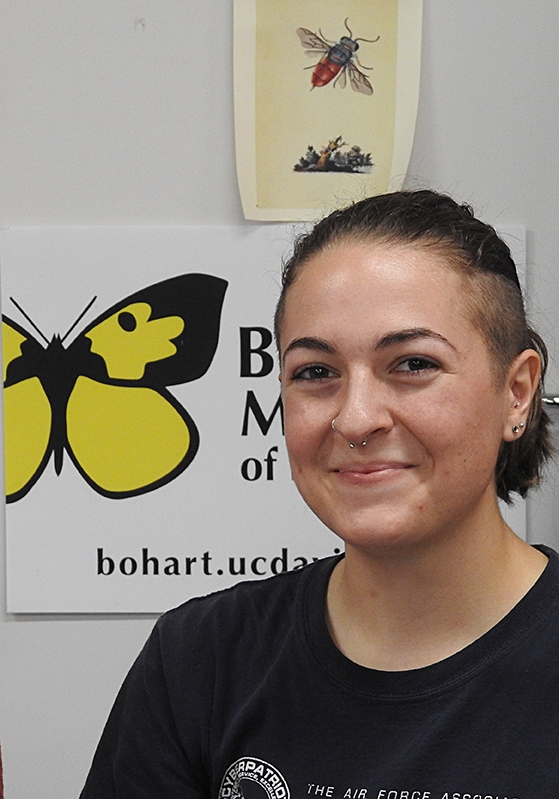
Yes? No? Maybe?
Entomophagy is no problem for scientists at the Bohart Museum of Entomology, University of California, Davis. They know where the office snacks are kept.
The items include…drum roll…chocolate-covered cicadas.
Chocolate, did someone say chocolate? Ooh, chocolate! Let me at ‘em!
During a break, Bohart scientists recently sampled/snacked on the delicacy.
Roll call:
- Lynn Kimsey, director of the Bohart Museum of Entomology and distinguished professor of entomology, UC Davis Department of Entomology and Nematology
- Brennen Dyer, UC Davis graduate in entomology and Bohart Museum lab assistant
- Iris Bright, Bohart associate, future professor and a researcher in the nearby lab of Jason Bond, the Evert and Marion Schlinger Endowed Chair in Insect Systematics, UC Davis Department of Entomology and Nematology
- Maxwell Arnold, 4th year UC Davis undergraduate in entomology and a member of the forensic lab of Robert Kimsey, UC Davis Department of Entomology and Nematology
- Amberly Hackmann, 3rd year UC Davis undergraduate in entomology and a student lab assistant at the Bohart Museum
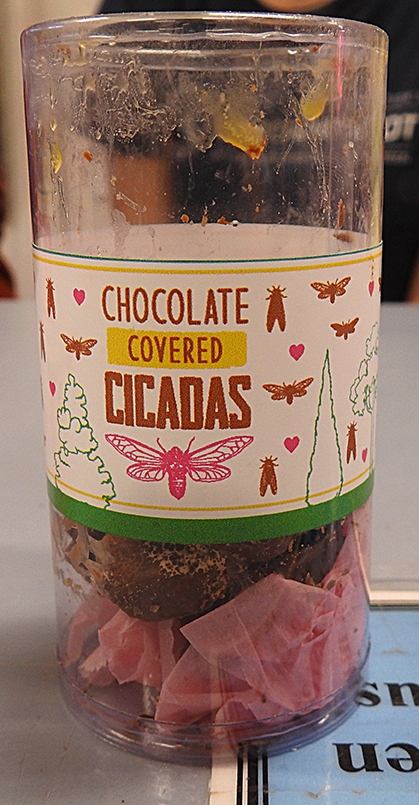
How did you like the chocolate-covered cicada treats?
Kimsey: "Not much."
Dyer: "They're an interesting snack, for sure. But I'm not a big fan of them, honestly."
Bright: "I like them, maybe not my go-to chocolate treat, but not bad!"
Arnold: "I've eaten worse things. "
Hackmann: "It was a fun and tasty chocolate!"
What did they taste like? Description?
Kimsey: "Tasted like chocolate-covered paper." (The jars had previously been opened)
Dyer: "I mostly tasted the chocolate and flavorings since cicadas have quite hollow bodies, but I would say they have a light nutty flavor. Much more pleasant than crickets, which have a strange aftertaste in my experience."
Bright: "The spices in the chocolate were really nice and then the cicada itself just added a fun crunch but not much flavor, similar to a malt ball!"
Arnold: "Tasted like stale chocolate, the cicada only contributed by getting stuck in my teeth."
Hackmann: (Tasted) "Like chocolate with crunchy, flavorless fibers."
Would you eat them again?
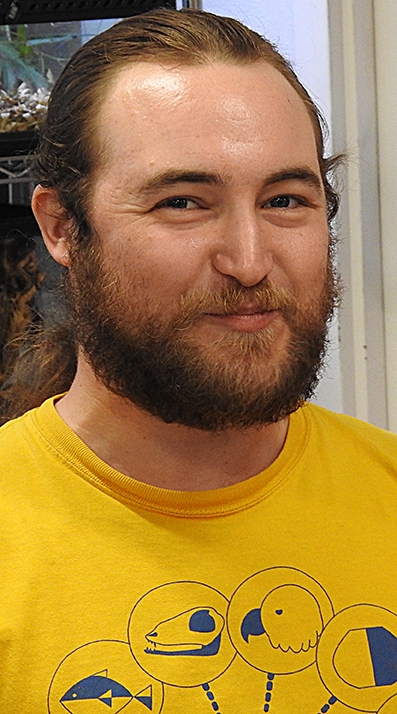
Dyer: "I wouldn't eat them again, to be honest. I believe the wings were still attached, which don't have a nice texture. I'd be happy to try cicadas again but in another form. Perhaps a savory meal instead, like stir fry or fried rice."
Bright: "Definitely! That was actually my third one!"
Arnold: "If they were fresher, why not?"
Hackmann: "Yes, it's a good snack for when I didn't bring enough food to work. "
Have you eaten (or enjoyed) other insects?
Kimsey: "Mealworms are good, crickets not so much."
Dyer: "I've tried a few different insect foods, including gummy worms (the real deal), various mealworm snacks, chapul bars (cricket flour-based energy bars), and flavored crickets. I haven't had the chance to try full-on prepared meals that incorporate insects, though."
Bright: "I've eaten crickets, mealworms, and termites that tasted like cilantro (in Belize)! I've also accidentally eaten a Hemiptera that was hiding on a blackberry, which was not so pleasant."
Arnold: "I enjoy mealworms with butter and salt (tastes just like popcorn)"
Hackmann: "Yes, I've eaten mealworms, ants, and crickets as well."
Opinions differed at the Bohart tasting, but patrons at a chocolate shop in Bethesda, Md., loved them during the Brood X Periodical Circada explosion.
A Reuters news story related that chocolate-covered cicadas were literally flying off the shelves last June at a chocolate shop in Bethesda, Md. Owner Sarah Dwyer of Chouquette Chocolates pointed out a 10-day backlog of orders.
She froze, boiled, cleaned, crisped (in air fryer) and then fried them. She sprinkled some with cinnamon and others with Old Bay Spice, and then dipped them in chocolate.
“I did go to pastry school in Paris to learn my dipping technique," Dwyer told Reuters. "I'm pretty sure no one thought I would be using it on cicadas."
Bohart Open House on Entomophagy in 2019
The Bohart Museum, currently closed to the public due to COVID-19 pandemic precautions, hosted an open house in September of 2019 to give the public a taste of entomophagy. The theme: "Gobble, Gobble, Munch, Munch, Crunch: Entomophagy." Visitors ate crickets, earthworms and mealworms and received a button proclaiming "I Ate a Bug at the Bohart."
A display, titled "Bug Buffet," drew widespread interest: "Have you ever eaten ant pancakes or scorpion scaloppini? Well, eating bugs (entomophagy) is a lot more common than you might think. All round the world, people eat delicious and nutritious insect delicacies."
The dishes mentioned on the display:
- Locust Biscuits, featuring the brown locust, Locustana pardalina
- Mexican Caviar, starring the giant water bug, Abedus herberti
- Termite a la Carte, featuring termites, order Isoptera
- Maguey Worm Tacos, with Maguey worms, family Megathymidae
- Raw Cossid Moths, starring the larvae of the cossid moth, Xyleutes leucomochia
- Fried Pupae, presenting the pupae of the silkworm moth, Bombix mori
The Bohart Museum, located in Room 1124 of the Academic Surge Building on Crocker Lane, houses a global collection of nearly eight million specimens. It is home to the seventh largest insect collection in North America, and the California Insect Survey, a storehouse of the insect biodiversity. It also maintains a live "petting zoo," comprised of Madagascar hissing cockroaches, stick insects and tarantulas; a year-around gift shop (now online), stocked with T-shirts, sweatshirts, books, jewelry, posters, insect-collecting equipment and insect-themed candy.
More information on the Bohart Museum is available on the website at http://bohart.ucdavis.edu.
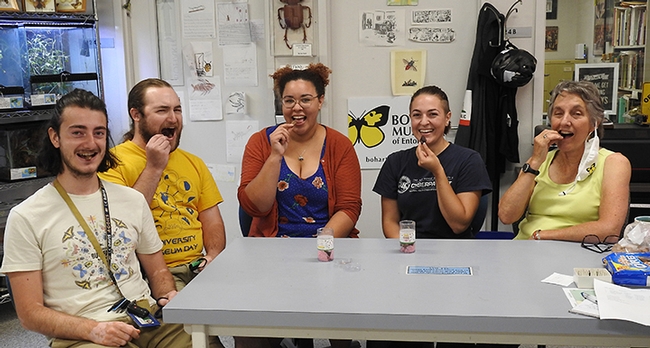
- Author: Kathy Keatley Garvey
You've probably read the children's book, "Where's Waldo?"
Waldo wanders around the world, gets lost in the crowd or scenery, and it's your job to find him. Where'd he go?
If you have a praying mantis in your yard, you probably play "Where's Waldo?" a lot.
In our yard, it's "Walda." She's a gravid (pregnant) praying mantis and she never stays in one spot for long.
Camouflaged in the bushes, motionless, and deep in "prayer," she's a lost cause.
And then you see where she is. The Stagmomantis limbata. The bushes stir, and the next thing you know, she's gripping a bee in her spiked forelegs.
Where's Walda?
Right there. Right there.
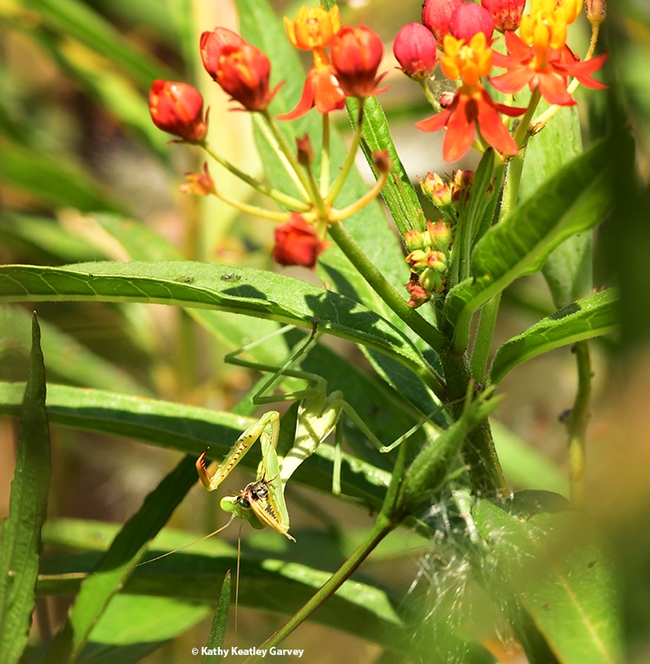
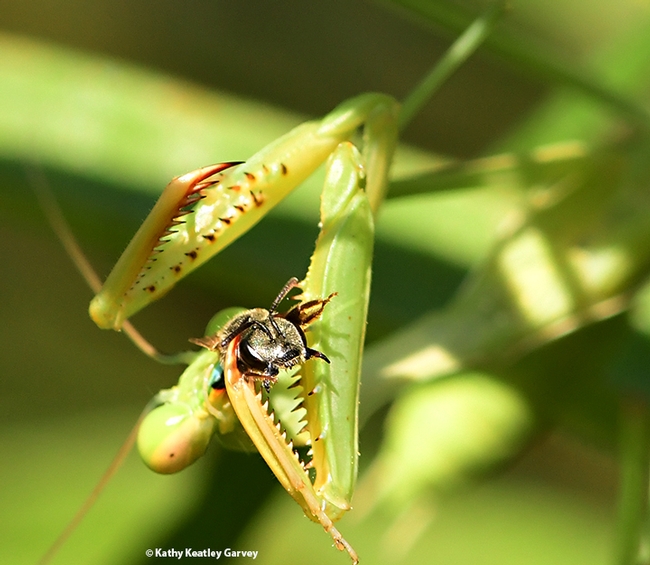
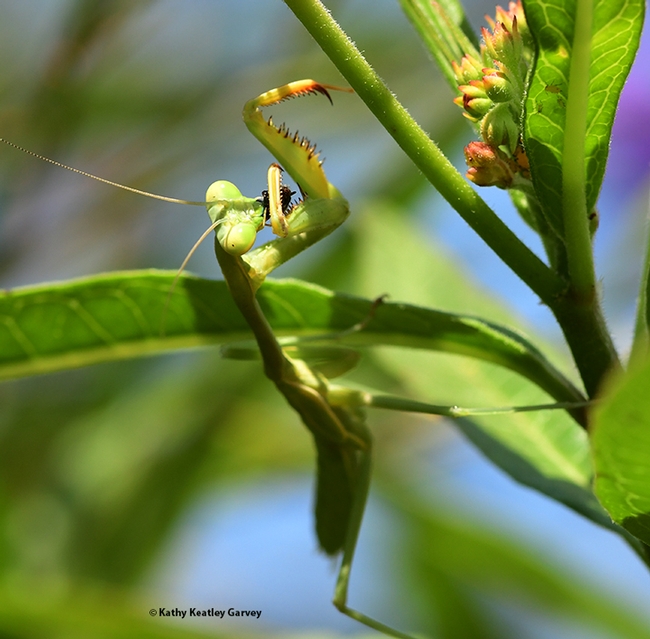
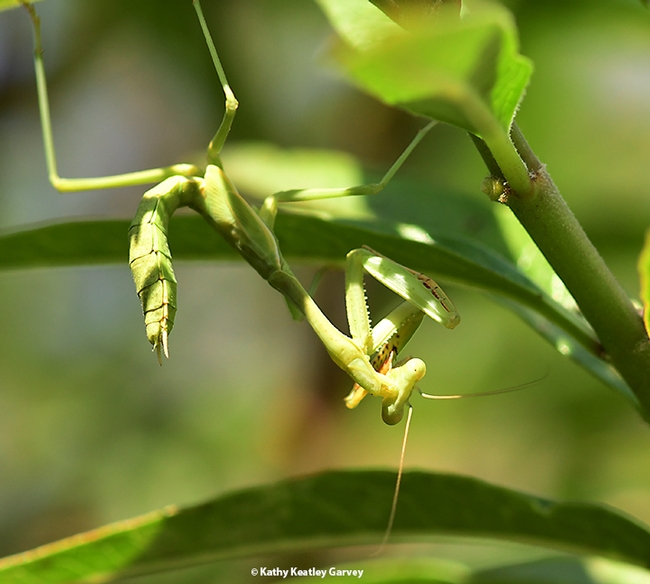
- Author: Kathy Keatley Garvey
So, here you are, a honey bee nectaring on a Mexican sunflower, Tithonia rotundifola.
All's right with the world, at least in your world. You're sipping nectar to take home to your colony and suddenly...a buzz.
A male long-horned bee, probably Melissodes agilis, is trying to dislodge you from your flower.
You hold your ground (your flower) but you let him know that his presence is unwanted. You lift a foreleg in your defense to block him.
The long-horned bee flies off, and you continue to nectar. All's right with the world. (Until your next encounter with a fast-moving, highly territorial male long-horned bee bent on dislodging you from your flower.)
The late Robbin Thorp (1933-2019), distinguished emeritus professor of entomology at UC Davis, used to say that these male long-horned bees target any critter residing on "their" flowers. It could be a honey bee, a bumble bee, a carpenter bee, a syrphid fly, a butterfly or a beetle. Or something else. They want to save the flowers for their own species and then mate with them, he said.
Just a day in the life of a non-native honey bee, Apis mellifera, and a native long-horned bee, Melissodes agilis.

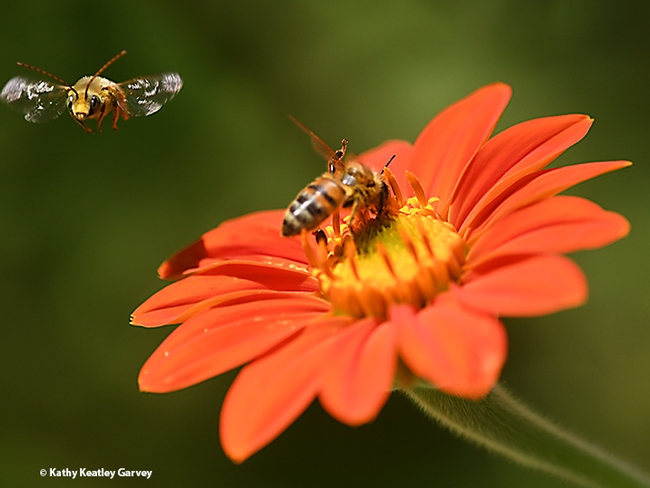
- Author: Kathy Keatley Garvey
Interviewer: "Hey, Gulf Fritillary! What happened to you? Something take a chunk out of your wings?"
Miss Gulf Frit: "I dunno. I was just fluttering around the passionflower vine and something grabbed me."
Interviewer: "Do you have any idea what happened?"
Miss Gulf Frit: "Sorry, no. It happened so fast but I managed to escape. A miss is as good as a mile, right?
Interviewer (turning to praying mantis): "Ms. Mantis, do you have any idea what happened here?"
Ms. Mantis: "What? You talking to me? You talking to me?"
Interviewer: "Yes, you're the only other one in the passionflower patch."
Ms. Mantis (smiling): "It wasn't me, y'hear. It wasn't me! Okay, well, maybe it was me. I was hungry. I'm still hungry. I missed!"
Interviewer: "Well, a miss is as good as a smile."
